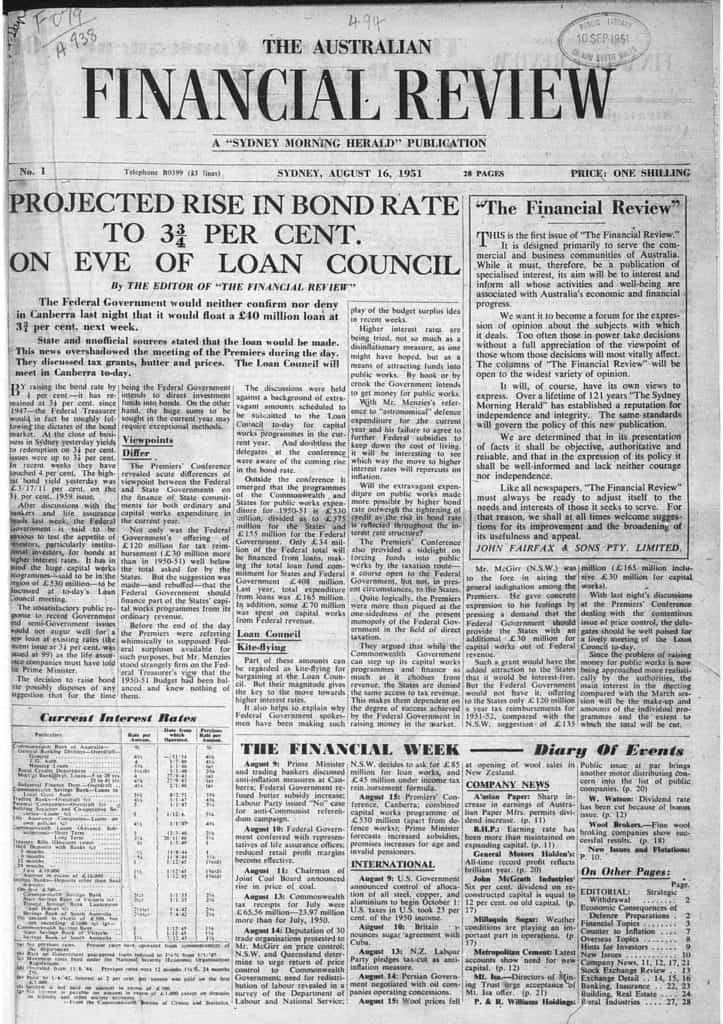Australia’s first national newspaper, The Australian Financial Review, will celebrate its 70th anniversary on Monday, August 16.
Mediaweek caught up with The Australian Financial Review’s editor-in-chief Michael Stutchbury to talk about the past, present, and future of the publication.
Since its first edition as a weekly Thursday newspaper on August 16, 1951, with a circulation of just 13,000 and a price of one shilling, Stutchbury said The Financial Review has played a unique role in charting Australian society.
“As part of this exercise, I have been going through the bound volumes of The Financial Review since 1951, every day, and I have gotten to 1972 and I am going to keep going.
“The thing that strikes me is that the best day-to-day, blow-by-blow, contemporary account of Australian business, the economy, financial markets and politics is in the pages of The Financial Review which are in bound volumes and are held hostage in warehouses that no one really has access to.”

The first edition of the Australian Financial Review
Stutchbury said that this celebration of the history of The Financial Review is in part to help bring out all the history the publication has covered in those bound volumes.
“In 1951 there were 8 million people in Australia, it was very Anglo, the main exports were dominated by wool and wheat, there was no real mining sector. The story of Australia over that time was how we transformed from an English empire orientated agricultural exporter to becoming an exporter of iron ore, coal, and gas to Japan, South Korea, Taiwan and then China over the years.
“It gives you a sense of how the country can change. There are certain things that are constant like this large landmass at the foot of Asia.
“It helps you show that Australian prosperity has had a number of transformations, and we have gone through one in the past six or seven decades and we are going through another one now through transforming the natural resource base to the low carbon world.”
When asked what some of the interesting things were that he has noticed when reading through the archive of The Financial Review, Stutchbury pointed to a few different examples.
“The banks weren’t that big in the old days; it is only in recent times that the big four banks were that big.
“We ran a picture on page one in 1962 of the AMP building on Circular Quay, 28 stories and was the tallest building in Australia at that time. We have written since then really the decline of the AMP Society which would have been the biggest financial institution in Australia at the time.
“We really wrote the story of the rise and fall of industry protectionism where Australia built up an import protection wall around the country and that had a lot of bad effects and that wasn’t really till the 80s that it started to come undone under the Hawke/Keating governments. We played a prime role since the 50s in arguing against protectionism in Australia and opening the economy up to the world.
“We also chronicled all the scoundrels and corporate busts from the 60s, 70s, through to the last decade or so and that has been a few rollicking tales. Alan Bond arrived in Australia in 1951 as a 12-year-old boy and in a couple of years, he was in trouble with the police and by 1992 he was facing jail.
“It is the story of the people who built Australia up through the business world.”
Celebrating 70 years of the Australian Financial Review
The week of celebrations will kick off with a 12-page wrap-around commemorating the leaders who have most defined the growth of Australia’s business sector over the past seven decades.
The wrap-around will also feature highlights of The Financial Review’s reporting, including a look back at the Canberra Observed column that began in 1957 and the debut of the daily Chanticleer business column in 1974.
Throughout the week there will be special stories both in print and online, rounding out with a commemorative 76-page Platinum 70 Magazine featuring an exclusive cover story with Apple chief executive Tim Cook.
The special edition will also include interviews with former Prime Ministers Paul Keating and John Howard, two political leaders who helped define their decades and whose policies have had a lasting legacy in shaping modern Australia.

The list of powerbrokers features iron ore pioneer Lang Hancock, financier Ian Potter, Westfield founder Frank Lowy, media mogul Rupert Murdoch, BHP’s Ian McLennan, Macquarie’s David Clarke and CSL’s Brian MacNamee.
When asked how they put together such an exclusive list of only seven people, Stutchbury said that he has used the pages of The Financial Review as a resource, and worked in conjunction with other experienced minds.
“I have read a lot of the papers going back to 1951 to get my head around earlier times.
“Also, Andrew Clark is writing a seven-part, decade by decade, series on the growth and development of Australian business since the 50s.
“I have worked in consultation with Andrew and Tony Boyd our chief Chanticleer writer. The three of us discussed it all and came out with our take on it.”

An interactive timeline detailing the history of Australian business and politics has also launched on www.afr.com.au. The timeline is a scroll through 70 years of booms, busts, empire-building, fraudsters, disrupters, and political landmarks from the masthead’s inception in 1951 to 2021.
Important parts of The Financial Review’s 70-year history
When asked about the important milestones in The Financial Review’s own history, Stutchbury pointed to becoming twice weekly in 1962, and then daily in 1963, but also mentioned how the publication was on the forefront of going digital.
“We had AFR.com in 1996, a very early version. We were a very early mover in having quite a high paywall and that’s paid dividends in terms of establishing a base to build a publication that is largely digital. Print is still very important and has a large revenue base for us but digital is clearly where the growth is.
“We have gone through the digital transformation and disruption of the last decade, and now we have been through the crisis and had an acceleration of this business model.
“The old Fairfax company and the Financial Review were early movers on transforming ourselves from a newspaper product to a genuine digital business masthead which is now in a growth period.
“We are now a leading example in Australia and maybe even of the world of a premium digital publication.”

The future of The Australian Financial Review
When asked about the future of The Financial Review, Stutchbury said that the publication is in a growth phase.
“We are actively looking at improving the quality of our digital presentation, of ways to more deeply engage with readers and subscribers and following the model set by the Financial Times of really growing our B2B subscription base.
“If you are a decision-maker at a significant company in Australia it should just be expected the job comes with a subscription to The Australian Financial Review because of our position as the leading provider of business, finance and political news and analysis in Australia.”
Stutchbury also said that he wants to take lessons and look forward to the future and that is partially reflected in the events that they have planned.
“We had a cryptocurrency summit which we had to postpone due to Covid but was very much in the looking forward area of a number of events that we have planned.
“We also have a Street Talk event with the investment bankers around corporate mergers and acquisitions. We had a special event lined up for that, but we will put that off until we can all get back together again.
“Then we want to kick off a series of what we call Editors Forums looking forward at some of the big trends that Australia business and the economy are facing over the next decades. This includes the carbon transformation of the natural resource space, the digital revolution in banking and finance, and how technology is sweeping through infrastructure, which has been accelerated by the pandemic.”
Moving forward Stutchbury said that in The Australian Financial Review the story will be of people.
“The people that actually do these things, the entrepreneurs, those who risk capital, the leading people in businesses. It is the story of all the things that they do to try and build business and wealth for themselves and the overall country.
“More and more I see the Financial Review as being almost a business community paper in a way.”
